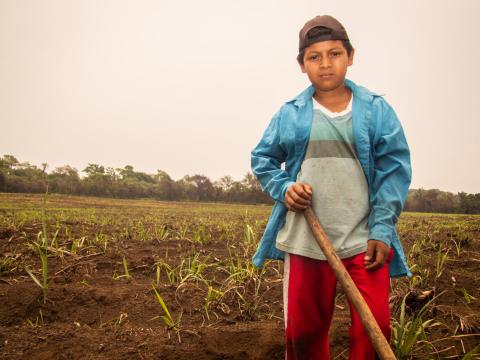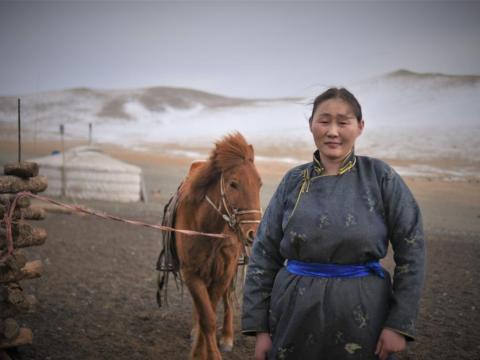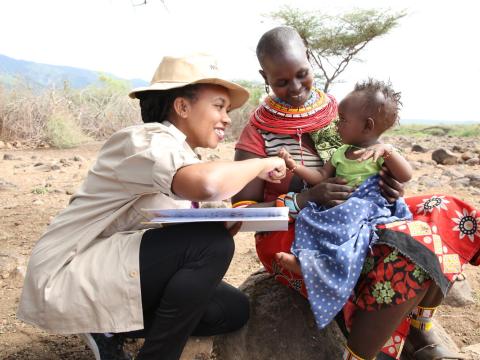
Lessons learned from 10 years of changing a child labour law
Harry Kits considers the important lessons learned after a decade of campaigning to have Canadian companies report on what child labour is in their products.
In May 2023, lawmakers told Canadian companies they would now have to report on what they are doing to address child labour found in the country's groceries, clothing, toys, and many other goods. This was fantastic news, not just for Canadian consumers who will be better informed when making their purchasing, but for the tens of millions of children globally forced into often hazardous work.
The decision that Bill S-211 the Fighting Against Forced Labour and Child Labour in Supply Chains Act should become law in Canada also caused celebration among World Vision Canada staff who had worked for this day for more than a decade.

World Vision Canada advocacy on child labour in corporate supply chains began with this challenge: “In 2012, the ILO estimated that there are 168 million children around the world engaged in various types of exploitative forms and conditions of work below the minimum age specified in their national context. Of that number, more than 85 million children perform hazardous work, i.e. the worst forms of child labour.” And still today, our most recent research report says that in 2021 Canada imported nearly $48 billion in goods at risk of containing child labour, representing over 7.5 per cent of our total imports.
Our public advocacy and consumer education campaign, No Child for Sale (NCFS), officially launched in June 2013, spurred on by the April 2013 Rana Plaza factory collapse tragedy. Our goal has been to increase awareness of, and seek legislative solutions to, the problem of child labour and forced labour in the everyday goods used by Canadians. Throughout the last decade the campaign has included a mix of research, public engagement, and public campaigning activities, as a support to direct government lobbying and advocacy work.
A decade long advocacy push might seem like never ending and demoralizing. How does an organization, and its staff, keep the momentum going? What are the principles for success for the long haul?

Here’s some of the principles that we kept in front of us, in what admittedly has been a hard slog for a decade.
1. Carry the file and nurture relationships
When World Vision started this work in Canada, no one else was actively working on child labour in supply chains. Early on World Vision was able to put the issue on the agenda for consumers, corporations and government. By sticking with it over time, and becoming subject matter experts, we could “carry the file” through constant changes in elected governments, government officials, and advocacy partners (and even our own staff). We could repeatedly provide background, opportunities, and ways forward on the file to new stakeholders.
Sometimes carrying the file, means in fact coordinating and passing information to different parts of government who have a stake in the issues. By being subject matter experts, you can facilitate, from the outside, the common information, intel, and opportunities between the relevant parts of government, literally carrying the file between them to ultimately move something forward.
Alongside the critical element of public voices (see below), the ultimate key to change is developing good relationships with decision-makers and supporting them to become champions for the change you are seeking. While these stakeholders also changed over time, and we had to carry the file to new ones, each relationship built on another. And in the end, there were a few critical decision makers, and their staff, with whom we worked most closely to achieve success, from across different parts and levels of the Canadian government.

2. Amplify the voice of youth, citizens and consumers
One of the challenges of child labour in corporate supply chains is that it is hidden. So consumers and stakeholders cannot know if girls and boys were involved in making the product we are purchasing -- in fact corporations themselves often don’t know. A critical part of our advocacy was amplifying the stories of children involved in dirty, dangerous and degrading jobs, of the consumers who wanted to be able to make ethical choices, and of citizens who wanted to act for change.
Many children and youth in Canada advocated for children trapped in child labour with media and directly to political decision makers. In 2018, World Vision won silver for the government relations campaign of the year at the Achieving Communications Excellence (ACE) Awards Gala.
The fact that there were very personal consumer actions that they could take and advocate for, along with advocating for systemic changes to Canadian law, made this an appealing issue and campaign for them. We produced ethical shopping guides for consumers on chocolate, coffee, fashion, makeup, and groceries. We created provocative TV ads, public stunts and public engagement activations such as Glam Van and our Child Labour Challenge.
We also amplified voices through petitions that Canadians citizens could sign by the hundreds of thousands, and which were presented to politicians. We engaged influencers, organized panel discussions and events, and actively pursued media stories and received front page and top tier stories with many millions of impressions.

3. Principled pragmatism and Relentless incrementalism
Achieving the win has taken both a principled pragmatism approach (proposing concrete and do-able solutions within political realities) and practicing relentless incrementalism (keep moving small steps forward).
Our ultimate goal is to end child and forced labour. However, we know that there are multiple changes needed and tackling the specifics of child labour in Canadian corporate supply chains was just one. Even there the road could take multiple paths, direct engagement with companies, global agreements and voluntary principles, legislation, etc. As we explored different avenues, we always kept the ultimate goal in mind, and the voices of children doing dirty, dangerous, and degrading work. But by pragmatically pivoting and shifting, with smart approaches, and constantly reading the corporate and political tea leaves, we took doable steps within what was possible at the time.
Advocacy can be a long journey and requires on-going commitment. We need to recognize and celebrate small wins along the road. In all the pragmatic choices we made, we kept moving the needle forward with small steps of progress – relentless incrementalism.

In order to demonstrate how child labour is a "Canadian problem" and to create a sense of urgency, we did our own original research to highlight the magnitude of the problem. This research included developing a methodology for multiple reports on the billions of dollars of imported goods into Canada at risk of involving child labour. The first report generated a front page story in one of Canada’s largest newspapers. Many many times a statistic like "$44B in risky goods," based on these reports, stat has been quoted by various government officials, politicians, partners, and the media. These reports, and other original research, generated countless media impressions and stories and incrementally built the case for change..
Based on our research and attention generating work, we lobbied the government to hold a study, we presented at the study, we responded to the government’s response to the study – several times. We had many, many direct meetings and built relationships with politicians and senior government officials, over the course of several federal elections, and a through a change of government. Rinse and repeat. In time, the government itself began to take up the issue more fully, with their own studies (with WVC’s continued pressure), consultations and private members legislation proposals. More and more frequently, the studies resulted in recommendations for supply chain legislation.
Eventually, in their election platforms for the fall 2021 election, both the Conservative Party and Liberal Party committed to introduce some form of supply chain legislation. In the post-election mandate letters from the Prime Minister, the Minister of Labour and other ministers were tasked with “introducing legislation to eradicate forced labour from Canadian supply chains and ensure that Canadian businesses operating abroad do not contribute to human rights abuses.” And both a Senator and a Member of Parliament introduced a private member’s bill which eventually became Bill S-211 which became law in May.

This bill is a significant milestone and important first step - but not the only one that needs to be taken. We see the power of incremental momentum from moments like these, and we will continue to advocate for further measures. We’re encouraged that our Minister of Labour Seamus O'Regan has committed his government to introduce the next round of legislation soon, that will extend the fight to eradicate all forms of forced and child labour in corporate supply chains and uphold human rights.
Harry Kits is World Vision Canada’s Senior Director for Advocacy and Government Engagement. Drawing on nearly 35 years of advocacy work, he leads the World Vision Canada Advocacy team to press the Canadian government to do everything within its means (legislative, regulatory, budgetary, programming, diplomatic) to promote the rights and dignity of the world’s most vulnerable girls and boys.


